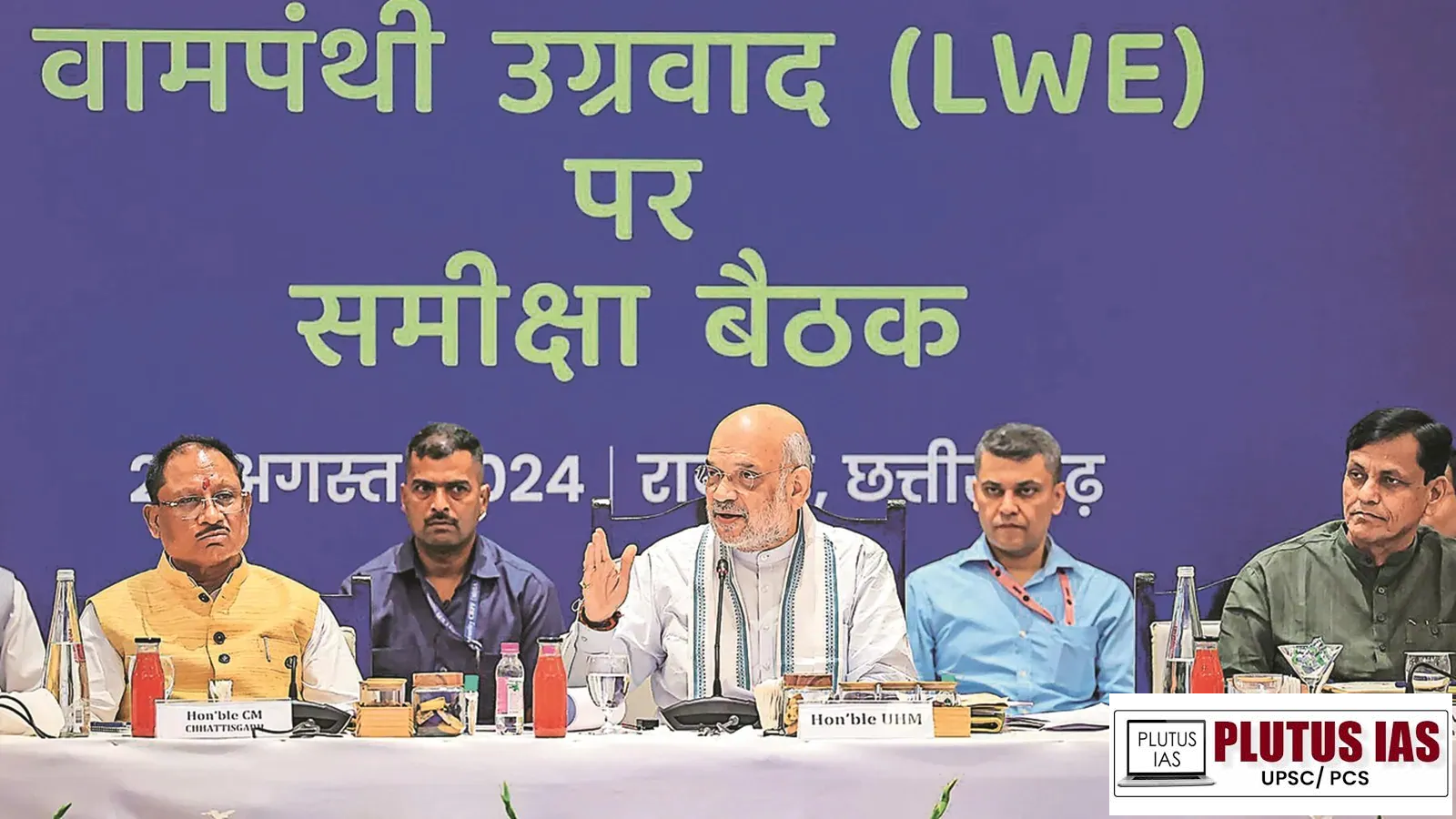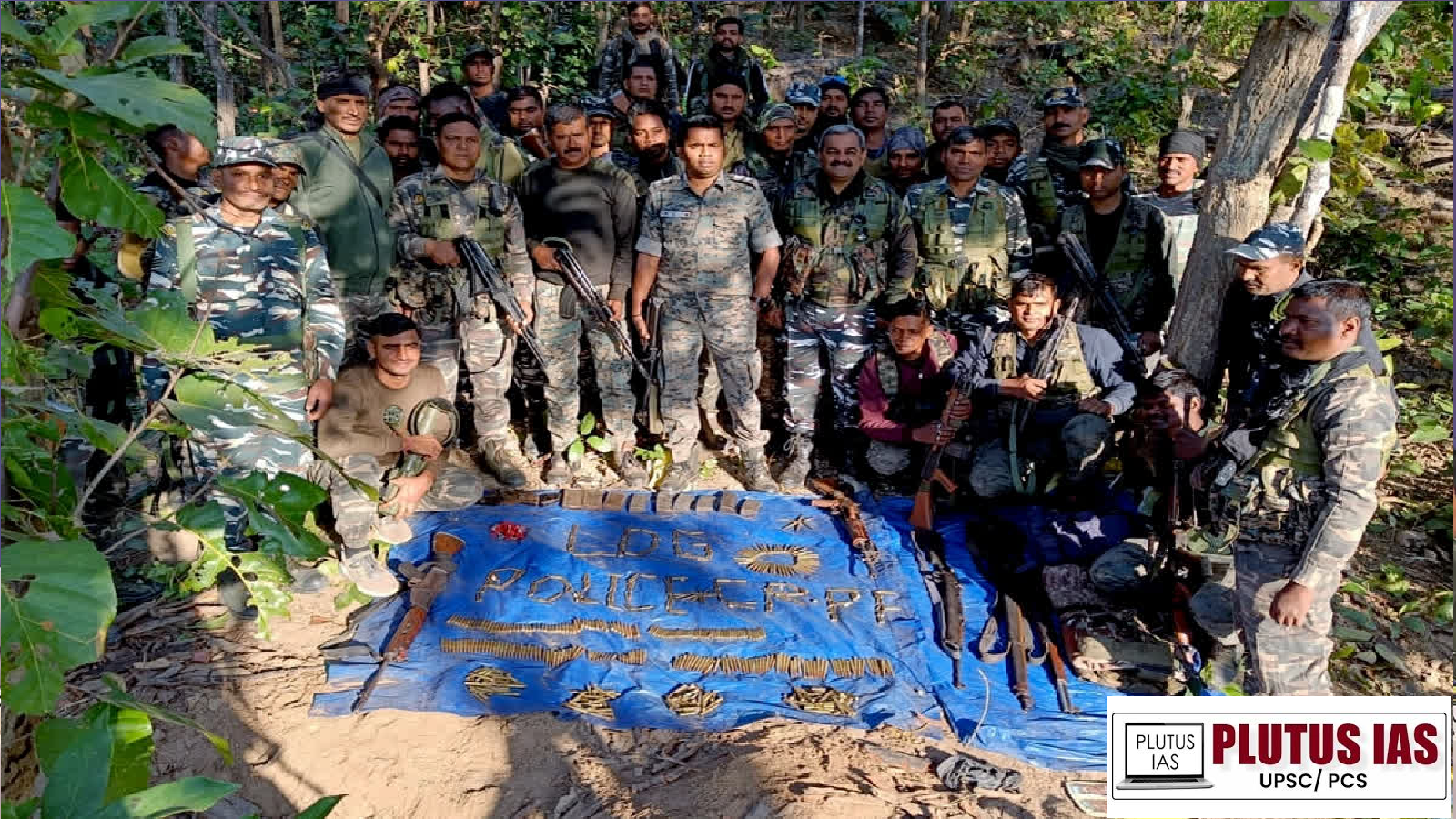21 Mar Left-Wing Extremism in India.
This article covers “Daily Current Affairs” and topic details of Left-Wing Extremism in India.
SYLLABUS MAPPING:
GS- 03- Internal Security : Left-Wing Extremism in India.
FOR PRELIMS
what is LWE and red corridor, Operation SAMADHAN initiatives.
FOR MAINS
Issues related LWE with in India, Challenges to Internal Security of India, Measures for Peace and Security in India.
Why in the News?
Recently, at least 30 Maoists and a policeman were killed in twin encounters in the Bijapur and Kanker districts of Chhattisgarh. These operations, involving nearly 2,200 security personnel from the District Reserve Guard (DRG), Special Task Force (STF), Central Reserve Police Force (CRPF), CoBRA, and Border Security Force (BSF), mark a significant escalation in anti-LWE efforts. This incident pushes the total Maoist casualties in Chhattisgarh beyond 100 for the year, highlighting the intensification of counter-insurgency measures. Security forces recovered a large cache of AK-47 rifles, automatic and semi-automatic weapons during the operation. The increasing success of such operations underscores the impact of coordinated intelligence-based strikes and the government’s commitment to eradicating LWE.

Data on LWE and the Red Corridor
The ‘Red Corridor’ refers to regions in India where LWE has a strong presence. This corridor primarily includes parts of states such as Chhattisgarh, Jharkhand, Odisha, Maharashtra, Andhra Pradesh, Bihar, and West Bengal. The Ministry of Home Affairs (MHA) has identified LWE-affected districts, categorizing them based on the intensity of violence and Maoist influence.
1. In 2010, around 223 districts were affected by LWE. However, by 2023, the number had reduced to approximately 70, with only 25 districts witnessing significant activity.
2. According to MHA reports, LWE-related violence has declined by nearly 77% since 2010, and civilian and security force casualties have also dropped substantially.
3. The states most affected remain Chhattisgarh, Jharkhand, and Odisha, with Bastar in Chhattisgarh being a key Maoist stronghold.
4. As per the latest data from the Press Information Bureau (PIB), as of December 2024, there are now only 38 LWE-affected districts in the country, marking a significant reduction.
5. Over the past five years, 60 districts have been freed from LWE influence, reflecting the success of government interventions.
6. Between 2014 and 2023, LWE-related incidents declined by over 52%, while overall deaths decreased by 69%. Security forces’ casualties reduced by 72%, and civilian deaths dropped by 68% compared to the period from 2005 to 2014.
7. For the first time in three decades, LWE-related casualties fell below 100 in 2022, underscoring a notable improvement in counter-insurgency operat
Causes of Left-Wing Extremism
The persistence of LWE can be attributed to a mix of socio-economic, political, and administrative factors:
1. Economic Disparities: Poverty, landlessness, and lack of employment opportunities in tribal and rural areas have fueled discontent. Exploitation of natural resources without adequate compensation or rehabilitation has further alienated local communities.
2. Political Alienation: Tribal and marginalized communities often feel ignored by mainstream political parties and institutions. The failure of local governance in providing basic services has pushed people towards extremist ideologies.
3. Administrative Lapses: Weak law enforcement and lack of adequate security infrastructure have allowed Maoists to operate with impunity in remote areas. Corruption in government schemes has deprived locals of essential benefits.
4. Social Injustice and Human Rights Violations: Police excesses and displacement due to infrastructure and mining projects have intensified grievances. The absence of proper rehabilitation measures for displaced communities has made them susceptible to Maoist propaganda.
5. Failure of Land Reforms: Land ownership disputes and the absence of effective land redistribution policies have fueled discontent among landless farmers and tribal communities. Illegal land acquisition by corporations and influential individuals has further deepened grievances.
6. Exploitation by Middlemen and Contractors: Tribals and rural poor often fall prey to exploitative middlemen in agricultural, forest, and labor markets. The lack of institutional financial support makes them dependent on moneylenders, leading to cycles of debt and exploitation.
7. Weak Law Enforcement and Security Gaps: The remoteness and difficult terrain of affected areas make law enforcement ineffective. Lack of sufficient police presence and slow response times allow Maoist groups to operate with relative impunity.
Government Policies to Address LWE
The Indian government has adopted a multi-pronged approach to counter LWE, focusing on security measures, developmental initiatives, and rehabilitation programs.
1. Security Measures: Operation SAMADHAN: Launched by the MHA, this strategy involves aggressive anti-Maoist operations, intelligence gathering, and coordination between central and state police forces. Deployment of Central Armed Police Forces (CAPF) such as CRPF and special battalions like the CoBRA (Commando Battalion for Resolute Action) to combat Maoists. Establishment of fortified police stations in vulnerable regions.
2. Developmental Initiatives: Special Infrastructure Scheme (SIS): Focuses on enhancing road connectivity, mobile towers, and essential services in affected regions. Aspirational Districts Programme: Aims at improving education, healthcare, and livelihood opportunities in backward districts. Skill Development and Employment Generation: Schemes such as MGNREGA and various state-led programs target job creation.
3. Surrender and Rehabilitation Policies: Incentives are provided for surrendered Maoists, including financial aid, vocational training, and reintegration into society. States like Chhattisgarh and Jharkhand have specific policies offering attractive rehabilitation packages.
4. National Policy and Action Plan (2015): Approved in 2015, this comprehensive strategy addresses LWE through security measures, development interventions, and ensuring the rights and entitlements of local communities.
5. Expansion of Road Networks: To improve connectivity in LWE-affected areas, the government has constructed 13,620 km of roads, facilitating better access and economic development.
6. Enhancement of Telecommunication Connectivity: A total of 13,823 mobile towers have been sanctioned, with over 3,700 already commissioned, to improve communication in affected regions.
7. Financial Inclusion Initiatives: To integrate local populations into the financial system, 4,903 new post offices, 955 bank branches, and 839 ATMs have been established in 30 most LWE-affected districts since April 2015.
8. Establishment of Security Camps: Since 2019, security forces have established 175 new camps in LWE-affected areas, reducing security vacuums and weakening extremist influence.
9. Choking of Funds: Efforts have been intensified to disrupt financial networks supporting LWE activities, targeting illegal funding sources to weaken their operations.
Challenges in LWE Elimination
Despite significant progress, several challenges hinder the complete eradication of LWE:
1. Geographical and Terrain Challenges: Maoists operate in dense forests and hilly terrains, which provide natural cover and make security operations difficult. The absence of proper roads and communication networks in these areas hampers counter-insurgency efforts.
2. Local Support and Ideological Appeal: Maoists continue to find support among marginalized and tribal communities who feel alienated from mainstream governance. Socio-economic grievances such as land displacement, unemployment, and lack of basic amenities fuel Maoist recruitment.
3. Security Personnel Casualties and Resource Constraints: According to MHA data, over 12,000 people, including civilians and security personnel, have lost their lives in LWE-related violence since 2000. Improvised Explosive Devices (IEDs) remain a significant threat, with a majority of security personnel casualties attributed to such attacks. The need for better coordination between state and central forces remains a challenge, as jurisdictional conflicts sometimes hinder operations.
4. Financial and Logistical Support to Maoists: Maoists continue to fund their activities through extortion, illegal mining, and levies on contractors and businesses. Despite efforts to cut off their funding sources, Maoists have adapted by using covert channels and digital transactions.
5. Slow Implementation of Developmental Projects: Government initiatives aimed at uplifting affected regions often face delays due to corruption, bureaucratic inefficiency, and lack of accountability. The Aspirational Districts Programme and other schemes need to be implemented more effectively to win the confidence of local communities.
6. Use of Advanced Warfare Techniques by Maoists: The adoption of modern guerilla warfare tactics, including drones, encrypted communication, and cyber-propaganda, poses new challenges for security agencies. There is an increasing need for intelligence-based operations and technology-driven counter-insurgency strategies.
7. Human Rights Concerns and Excessive Use of Force: Reports of civilian casualties, wrongful detentions, and police excesses have led to criticism and sometimes even strengthened Maoist propaganda. A balanced approach that ensures security operations do not alienate the local population is crucial to maintaining legitimacy.

Recent Trends in LWE
1.Declining Influence: A significant reduction in Maoist violence and territorial control has been observed over the past decade. Several top Maoist leaders have been arrested or neutralized, weakening their operational capabilities.
2. Shift in Strategy: Maoists have increasingly relied on IEDs (Improvised Explosive Devices) to target security forces instead of direct confrontations. There has been an effort to radicalize youth and use digital platforms for propaganda and recruitment.
3. State Success Stories: Andhra Pradesh and Telangana have largely curbed Maoist influence through effective governance and security strategies. Jharkhand and Odisha have significantly weakened insurgent networks with sustained operations and development work.
4. Targeting Infrastructure and Government Projects: Increased attacks on road construction projects, mobile towers, and railway networks indicate an effort to prevent government penetration into strongholds. Destruction of schools and health centers in some affected districts shows resistance to developmental activities aimed at winning over local communities. Extortion from contractors and businesses continues to be a major source of funding for LWE groups.
5. Growing Surrender and Rehabilitation Numbers: More Maoist cadres are surrendering due to government amnesty policies and an improved security presence. State governments have successfully rehabilitated surrendered extremists with livelihood opportunities and social integration measures. The internal divisions within Maoist factions have also led to desertions, further weakening their operational strength.
Further Course of Action
1. Strengthening Security Measures: Enhancing inter-state coordination for intelligence sharing and joint operations.Investing in modern technology such as drones, satellite imagery, and AI-driven surveillance for better tracking of insurgent movements. Expanding the presence of special counter-insurgency forces in key Maoist strongholds while ensuring minimal collateral damage.
2. Accelerating Development Initiatives: Ensuring effective implementation of government schemes with transparency and local participation. Promoting local governance and empowering Panchayati Raj institutions to address grievances at the grassroots level. Establishing more residential schools, healthcare centers, and vocational training institutes to bridge developmental gaps.
3. Winning Hearts and Minds: Engaging with local communities to build trust and reduce Maoist influence. Expanding educational opportunities and skill training programs tailored to the needs of affected populations. Strengthening civil society participation in governance and decision-making processes to ensure inclusion and representation.
4. Reinforcing Rehabilitation Programs: Improving incentives for Maoists willing to surrender. Providing long-term employment opportunities to prevent recidivism. Creating specialized support groups for rehabilitated individuals to ensure their smooth reintegration into society.
5. Addressing Root Causes of Radicalization: Establishing independent monitoring bodies to ensure the protection of human rights in counter-insurgency operations. Providing alternative leadership opportunities for youth in affected regions to divert them from extremist ideologies. Strengthening laws and policies to prevent exploitation of local resources by corporations without fair compensation to the affected communities.
Conclusion
Left-Wing Extremism remains one of India’s most persistent internal security challenges, but significant progress has been made in its containment. A combination of strong security action, targeted developmental programs, and community engagement has yielded positive results. However, to achieve complete eradication, the government must continue its efforts to address the root causes while maintaining a balance between force and welfare. The future course must involve holistic development, inclusive governance, and technological advancements in counter-insurgency operations to ensure lasting peace and prosperity in affected regions.
Download Plutus IAS Current Affairs (Eng) 21st Mar 2025
PRELIMS Questions:
Q.Consider the following statements regarding Left-Wing Extremism (LWE) in India:
1. The term “Red Corridor” refers to regions with a high presence of Maoist activities.
2. LWE is primarily concentrated in northeastern states of India.
3. The number of LWE-affected districts has decreased over the years due to government interventions.
Which of the statements given above is/are correct?
(a) 1 and 2 only
(b) 1 and 3 only
(c) 2 and 3 only
(d) 1, 2, and 3
ANSWER: B
MAINS Questions:
(250 words, 15 marks)




No Comments